Stewardship at the Smithsonian
A lighted cabinet and a box on a closet shelf may be enough for you to display and protect your own precious collection of matchbooks or state spoons or Star Wars action figures, but caring for 155 million objects ranging from mosquitoes to mammoth bones is a bit more daunting. Dr. Skorton shares the never-ending challenges of the National Collections Program.
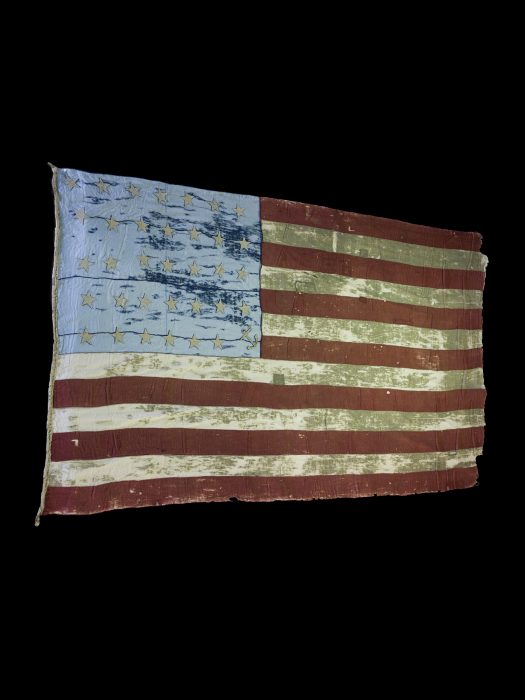
The name “Old Glory” was loudly proclaimed in 1824 by Captain William Driver as he hoisted the flag given to him as a birthday present. The flag would accompany Driver on his numerous voyages around the world. When he gave up seafaring and moved inland to Nashville, Tennessee in 1837, Driver continued to display the flag proudly by hanging it from a locust tree. He even updated the flag in 1861 to reflect thirty-four stars and added an anchor in the corner to indicate his sea service. When Tennessee seceded from the Union, Driver had the foresight to hide the flag and had his daughter conceal it inside a quilt, which was overlooked in numerous raids on his house. Old Glory remained in the quilt until February 25, 1862 when Ulysses S. Grant captured Fort Donelson and occupied Nashville. On that day Driver uncovered the flag, marched through the streets to the capitol building, climbed to its dome, and hoisted the flag for all to see. (Mary J. D. Rowland, National Museum of American History)
When James Smithson (1765-1829) wrote his will, he was quite vague about how he envisioned his institution for “the increase and diffusion of knowledge.” The United States Congress debated for a decade whether the Smithsonian should be a library, university, astronomical observatory, scientific research institute, or a museum. A quintessential American political compromise, the 1846 act establishing the Smithsonian included almost all of these things. The first Smithsonian Secretary, Joseph Henry (1797-1878), a physicist, wanted the Smithsonian to primarily be a scientific research institute. In 1850 he hired the first Smithsonian curator, Spencer Fullerton Baird (1823-1887), a naturalist, ornithologist, ichthyologist, and renowned collector. When he arrived in the fall of 1850, Baird brought with him two railroad box cars of his own personal collections, some 6,000 natural history specimens.
In 1858, the Smithsonian took its first big step towards becoming the official United States National Museum when the government’s scientific specimens were transferred to its possession and Congress approved the first federal appropriation to care for these national collections. Baird, who became the Smithsonian’s second Secretary in 1878, devoted himself to the collections. The rest, as they say, is history.
Today, the Smithsonian’s collections comprise more than 155 million objects and specimens, 162,000 cubic feet of archival material, and more than 2.1 million library volumes. Only about one percent of our collections are on public display at any given time; the bulk—more than 145 million items—are part of the National Museum of Natural History, and are used primarily for research, study and the advancement of public welfare.
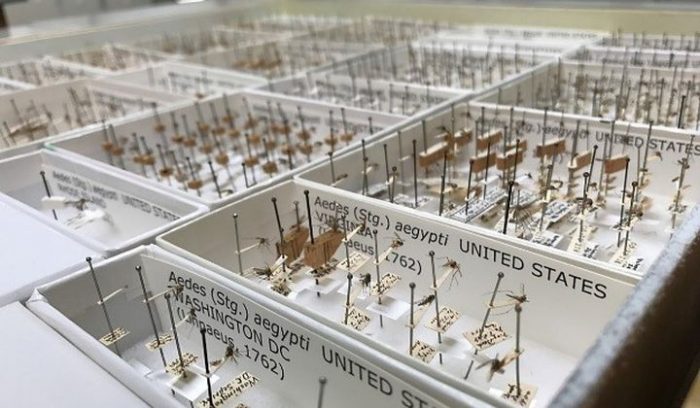
A drawer of pinned adult mosquitoes from the Smithsonian’s National Museum of Natural History’s National Mosquito Collection. The specimens shown here were digitized recently. Meaning, their bionomic information is databased and individual specimens are cataloged. (David Pecor, WBRU)
For example, the Smithsonian’s National Mosquito Collection was part of a now famous study spearheaded by Major Walter Reed of the U.S. Army in the early 20th century, implicating the mosquito Aedes aegypti as the species responsible for spreading the deadly yellow fever virus to humans. Armed with this knowledge, along with information about this specific species’ biology, the U.S. military was able to launch a vigorous and ultimately successful campaign against this enemy, allowing the completion of the Panama Canal.
Flash forward more than 100 years and researchers from the Natural History Museum and the Smithsonian Tropical Research Institute are using data from the collection to learn what people can do to reduce the risk of encountering this dangerous species, again wreaking havoc as the primary vector of the Zika virus.
Collections are central to carrying out the Smithsonian’s mission, serving as the intellectual base for much of our scholarship, discovery, exhibition, and education. Whether acquired from the depths of the ocean or the reaches of outer space, the National Collections encompass everything from art and aeronautics to zoology and zymology, making the Smithsonian a vital repository of knowledge for millions of visitors and many researchers each year.
The volume, diversity, and age of our collections and their accompanying standards of care make management as complex as the collections themselves. Collections care requires a multi-disciplinary approach guided by clear policy, professional ethics, and dedication to collections stewardship. A coordinated, collaborative approach is among the Smithsonian’s highest priorities, and is the central mission of the National Collections Program, which has been headed by Bill Tompkins since 1993 and includes Collections Management Specialist Samantha Snell and Collections Program Specialist Amelia Kile.
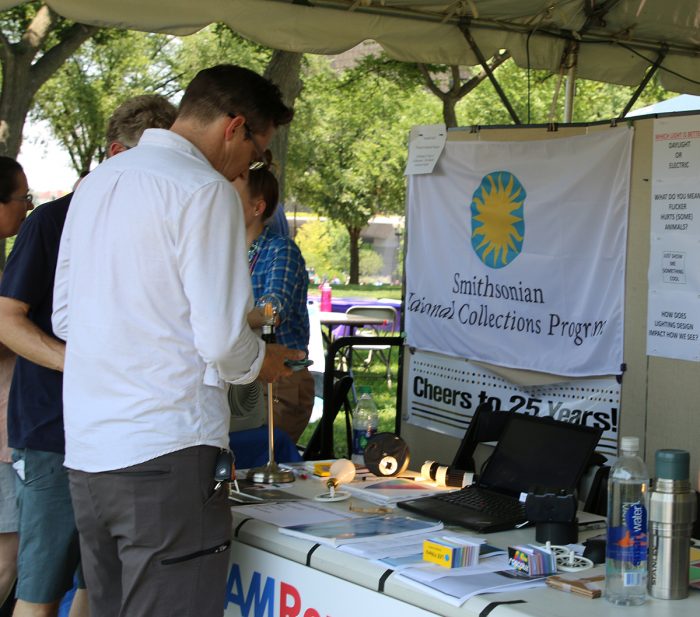
The National Collections Program hosted “Celebrating 25 Years of Collaboration” in the Congress of Scholars Tent at the 2018 Smithsonian Staff Picnic.
“Our office is dedicated to improving the overall stewardship and management of Smithsonian collections by providing central leadership, policy oversight, strategic planning, and support of Institution-wide collections initiatives,” Bill says. “I love my job because we empower, enable, and support those directly and indirectly responsible for the stewardship of the National Collections.”
NCP ensures collections are acquired, maintained, and used in accordance with Smithsonian policy, professional standards, and legal obligations. The office also administers funding to strategically address high-priority needs. Smithsonian collections receive specialized care from 23 authorized collecting units dedicated to a variety of disciplines and materials, including:
- Artworks
- Historical artifacts
- Natural and physical specimens
- Archives and libraries
- Living plants and animals
- Digital media
- Cryogenic samples
Addressing the challenges of caring for such immense and diverse collections requires a coordinated, interdisciplinary Smithsonian-wide approach to care, space planning, emergency management, collections digitization, and the preservation environment. With NCP leadership, coordination, and support, the Smithsonian has raised the level of collections stewardship based on sound assessment data, innovative collections care methodologies, economies of scale, and prioritized project-driven activities.
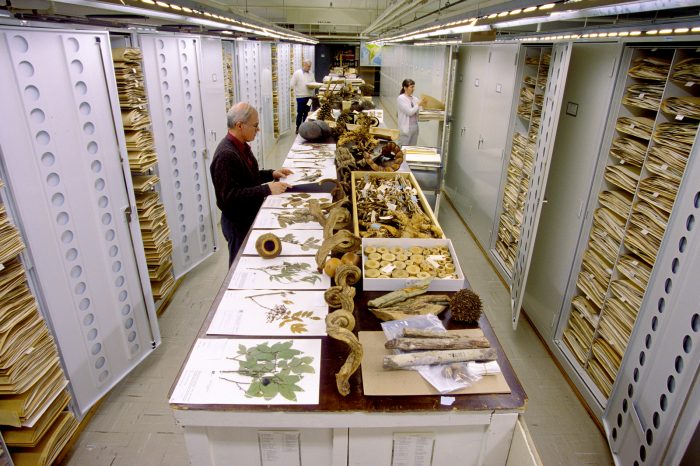
Botanical collections are displayed at the Smithsonian Institution’s National Museum of Natural History. Botany staff present are Dr. David Bruce Lellinger (left, front), Carol Kellof (right, middle), and Rusty Russell (left, back). (Photo by Chip Clark)
Collections Care and Preservation Fund
The Collections Care and Preservation Fund was established in FY 2006 to strategically address critical needs in collections care and preservation. Administered by NCP and the Smithsonian Collections Advisory Committee, CCPF provides funding to make targeted improvements in the accountability, documentation, preservation, storage, and accessibility of the Smithsonian’s collections.
“We’re committed to making the data we collect about our collections accessible to staff,” Amelia says. “Remembering the Smithsonian’s purpose when it comes to internal operations enables us all to make the best decisions to plan for the future.”
From FY 2006—FY 2018, $51 million has been allocated to unit-based and pan-Institutional collections care projects—strengthening the preservation and accessibility of millions of collection items, ranging from national icons to frozen biomaterials. The deadline for submitting FY 2019 CCPF proposals is November 16, 2018.
Collections Space Framework Plan
Although the Smithsonian had made significant improvements in collections care and space through major Facilities Capital projects in recent years, the collapse of Building 21 at the Paul E. Garber Facility of our Suitland campus in Maryland on February 10, 2010 during the “Snowmageddon” winter storm served as a wake-up call—recognizing that substandard conditions existed in some facilities housing collections and acknowledging the need for short and long-term planning to address current and future Smithsonian collections space.
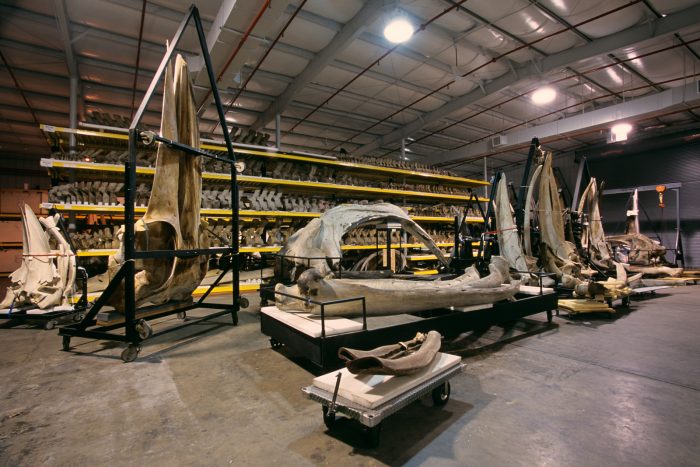
Whale skeletons from the Department of Vertebrate Zoology’s marine mammals collections are displayed in storage at the Smithsonian Institution’s Museum Support Center (MSC), located in Suitland, Maryland. (Photo by Chip Clark)
A multi-year collections space planning initiative was completed in 2015, co-chaired by NCP and Smithsonian Facilities, working closely with staff from collecting units and central offices. It culminated in a comprehensive Collections Space Framework Plan for addressing current and projected collections space requirements in a strategic, integrated, and collaborative manner. Existing conditions have been documented in a database that is routinely updated and analyzed to identify future improvements, including renovations to existing facilities, new construction and equipment procurements as part of a 30-year implementation plan. The Framework Plan has already had a major impact by funding critical space improvements at the Paul E. Garber Facility, the Museum Support Center, the Dulles Collections Center, and on the National Mall. Currently, NCP and Smithsonian Facilities are working toward the completion of the Suitland Collections Center Master Plan, which supports a phased development of the Suitland and Dulles campuses.
Collections Management Professional Development Program
The mission of the NCP’s Professional Development Program is to provide opportunities for Smithsonian staff to enhance their academic and technical training, continuing education opportunities offered by professional associations, and on-the-job experience.
Several collections professional development opportunities have been initiated through a partnership between NCP and the Smithsonian Collections Advisory Committee, including the Collections Share Fair, the C3distribution group, the C3 Brown Bag Series, a SharePoint site, and a Collections Information handout for all new SI employees.
The Collections Share Fair is an annual event open to all Smithsonian staff, fellows, volunteers, and interns for a celebration of the innovative techniques that have been developed by staff to care for our valuable collections.
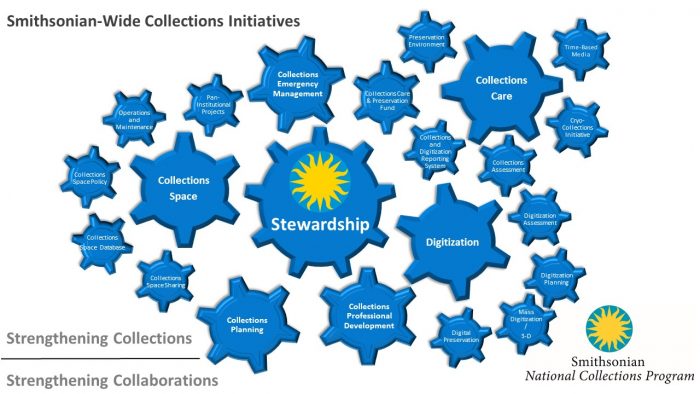
The graphic offers a quick overview of the various initiatives, programs and projects that the NCP leads, facilitates, and supports and demonstrates just how many gears must interlock and turn to keep the Smithsonian’s vast collections management engine machinery running smoothly.
The C3distribution group currently has more than 950 members, primarily collections staff, and is a tool to share information about training opportunities, resource sharing, and to increase communication between collecting units. The C3 Brown Bag lunch series is an opportunity for staff to learn about innovative collections care projects across the Institution and to create connections with folks who may have shared their presentations at conferences all over the world but perhaps not with their colleagues down the hall.
“One of the best parts of being at the Smithsonian is having an opportunity to work with so many talented people on a daily basis,” Sam reminds us.
Preparedness and Response in Collections Emergencies
In October 2016, the Preparedness and Response in Collections Emergencies team was formed with Snell as the chair.
PRICE is a pan-Institutional body that serves as the Smithsonian’s collections emergency support team. The purpose of PRICE is twofold: to advise and provide subject-matter expertise, consultation and assistance to NCP, Smithsonian collecting units, and Smithsonian senior management; and, when activated, to provide collections support, response, and recovery as part of the Smithsonian’s Emergency Operations Center.
Recent PRICE activities have included the establishment of PRICE Action Teams, ongoing site visits, wet salvage training, and fire recovery training. Water and fire are two of the most devastating threats to museum collections, so both the wet salvage and fire recovery training will be offered annually as professional development opportunities open to all staff.
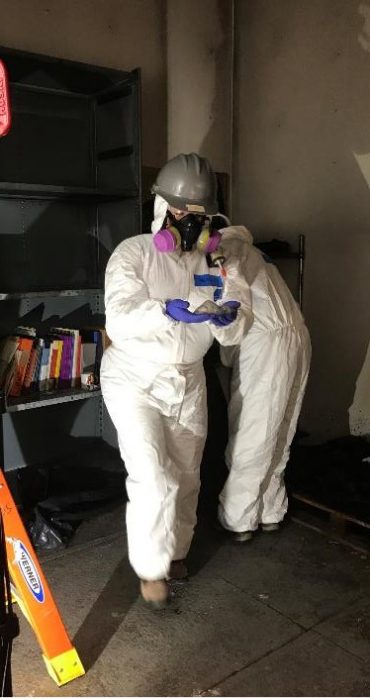
Participants in a recent fire recovery workshop held by PRICE learned how to best clean and preserve objects damaged by fire and smoke. (Photo courtesy Samantha Snell)
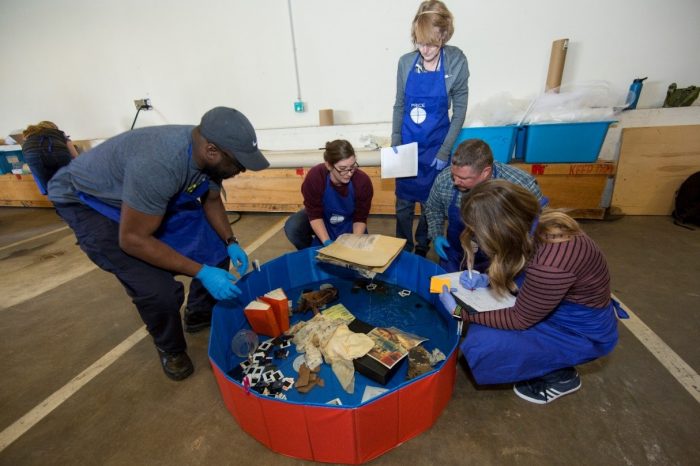
Training participants conduct triage on water-damaged items representing museum collections. (Photo by Michael Barnes)
When it comes to maintaining the National Collections, each and every member of the Smithsonian community plays a vital role in its stewardship. Regardless of title or position within the Institution, each of us contributes to achieving our founding mission—we are all stewards of these priceless national treasures.
Posted: 25 October 2018
-
Categories:
Art and Design , Collaboration , From the Secretary , History and Culture , Science and Nature







